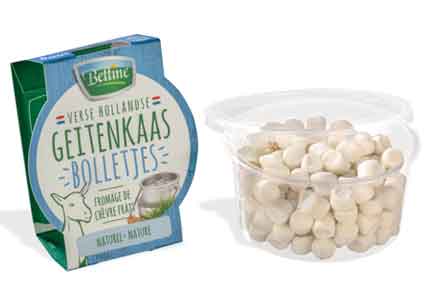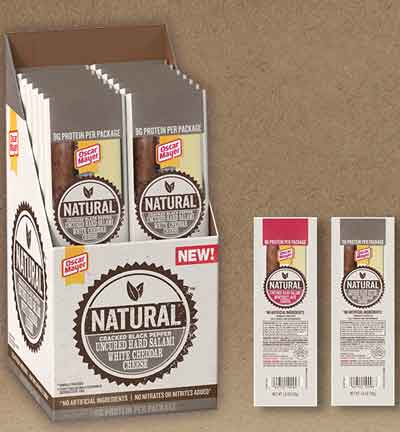Convenience packaging makes life easier for time-starved, active and nutrition-conscious consumers by offering safe food options with portion control and food waste reduction in mind.
No matter what the day might bring, convenience packaging makes quick meals and snacks easy and accessible. The need for convenient options across multiple dayparts continues to grow as consumers seek consumption hacks to combat work demands and increasing commitments. But catching the attention of busy consumers might be the most difficult part. Standing out from the crowd requires packaging with a range of easy-to-use attributes and branding and graphics that improve the messaging.
The desire for packaged convenience is not just a US phenomenon. Demand for convenience products is increasing around the world. In 2017, the business of snacking grew a phenomenal $3.4 billion globally. In the snacking arena, convenient protein options remain in high demand. Fifty-five percent of US households cite high protein as an important attribute with meat, eggs and dairy being the primary sources, according to Nielsen. In the ready-to-eat protein segment the emphasis is on snack meats, but packaging isn’t just about a quick bite. It also must meet needs for portability, portion control, food safety and address the ongoing problem of food waste.
“The throwaway culture of today will evolve into one that understands and embraces the role of packaging as a primary means to reduce global food and product waste,” says David Luttenburger, global packaging director, Mintel.
Quest for convenience
Reclosability continues to resonate with consumers looking for convenience, extended shelf life and portion control. Grocery and club stores known for offering large-volume packages geared to the cost-conscious consumer are now rethinking package sizing. Single-person and smaller family sizes mean the club-size is no longer the best option for everyone.
“Food waste is caused by multiple reasons, but an important one is the mismatch between the amounts of food inside the pack compared to the actual need of the consumer,” says Irene Buzzoni, marketing and communications coordinator, Sealpac, Harderwijk, The Netherlands. “Especially with the number of single-person households growing around the globe, this issue has become more evident.”
Kansas City, Missouri-based Multivac Inc. is finding packages built for consumer convenience are surging across all styles as consumers short on time prefer options with a multitude of pre-portioned components.
“Previously, in order to have a balanced grouping of processed meats, cheese, nuts, dried fruits, crackers, etc., consumers would purchase separate bulk packs of each, open them at home and portion them into zip-top bags,” says Cem Yildirim, strategic market development manager, Multivac. “Brand names would be left in the kitchen at home as snacks became anonymous.”
 The company offers single-portion, multi, medley, snack, reclosable, microwave, sous-vide and oven-ready packaging. Understanding the increasing importance of sustainability in packaging choices, the company offers its customers an immediate 10 percent to 20 percent savings on material and packaging costs by switching from pre-formed snack trays to thermoformed, filled on-line, sealed snack trays.
The company offers single-portion, multi, medley, snack, reclosable, microwave, sous-vide and oven-ready packaging. Understanding the increasing importance of sustainability in packaging choices, the company offers its customers an immediate 10 percent to 20 percent savings on material and packaging costs by switching from pre-formed snack trays to thermoformed, filled on-line, sealed snack trays.
Bemis Co., Neenah, Wisconsin, offers total packaging solutions for flex/flex and flex/rigid formats with the manufacture of lidding films, non-forming films, forming films and trays. Smaller, single-serve packages that incorporate a peelable lidding film and a flexible or rigid forming film are popular as they fit the snacking trend seen in beef jerky sticks and other meat options.
The company is observing many of its customers extending their product lines with smaller pack sizes, portion control and multi-serve packages. Its SmartTack Peel Reseal options are available in Peel Reseal films or Peelable Resealable labels, taking a five-component package to a two-to-three-component package. Peel reseal and peelable label packages that incorporate films and/or labels that peel and reseal have been popular in the lunchmeat category, according to Pete Bruehl, marketing manager-protein for Bemis. Combined with different print styles (natural, paper-like, back room finish and clean labeling) these attributes become an additional attraction for the packages.
“The combination of resealable, peel reseal, portion control, easy-to-open, easy-to-prepare and portion control are all draws for the consumer,” Bruehl says. “The need for package functionality with peel systems, portability, easy food prep and sustainability will continue to be a focus for category growth.”
New innovations and packaging efficiencies will be key throughout the protein segment, especially when you consider the new “Convenience Chasers” meat segment. Identified by Chicago-based Midan Marketing in its Meat Consumer Segmentation 2.0 report, the segment includes younger consumers of average income who are on the lookout for conveniently packaged meat to consume on-the-go or to be able to cook quickly.
Grocery, online and convenience categories continue to find success with smaller, handheld, easy-open meat and cheese pairings. In April, Kraft Heinz launched Oscar Mayer Natural Meat and Cheese Snack Sticks in the c-store channel. Oscar Mayer also makes the popular P3 Portable Protein Pack, which includes meat, cheese and nuts.
“Consumers are living busier lives, but they are less and less willing to sacrifice quality foods,” says Katie Hunstad, brand manager for Just Crack an Egg, Adult Meal Combos and Claussen at Kraft Heinz. “We find the migration to the store perimeter reflects the desire for food that is less processed. Additionally, the number of consumers checking labels for protein continues to rise.”
Natural Choice meat and cheese convenience packs from Austin, Minnesota-based Hormel feature protein with a sweet treat of chocolate-covered pretzels or almonds.
Snacking segment
Snacking will continue to increase in importance as the “fourth” meal occasion becomes more mainstream. Trends of convenience and portion control will be realized across a broader consumer base with the popularity of meat snacks at the center of those trends, Hunstad predicts.
Sealed Air Food Care, Charlotte, North Carolina, offers convenience packs including thermoformed and pre-made trays with easy-open, reclosable, ovenable and microwavable options. The company’s Cryovac Simple Steps, Cryovac OvenEase, Cryovac Multi-Seal FlexLOK resealable packaging, and small, single-serve protein packs are popular packaging options in the convenience segment.
“There’s a growing emphasis on sustainable packaging that effectively preserves and markets the product but also uses resources wisely and contributes to a circular economy,” says Mike Rosinski, marketing director of smoked and processed meats, Sealed Air Food Care.
 Midan Marketing sees many of its clients elevating consumer concerns about environmental impacts and convenience by offering more smaller size packaging and improved recyclable options, including an innovative solution using compostable packaging materials.
Midan Marketing sees many of its clients elevating consumer concerns about environmental impacts and convenience by offering more smaller size packaging and improved recyclable options, including an innovative solution using compostable packaging materials.
“Our clients want to work with packaging companies to attractively merchandise meat as efficiently as possible,” says Steve Hixon, strategic and business services director, Midan Marketing.
No matter the product, packaging solutions must continually meet the highest demands of freshness, product safety and shelf life. Sealpac is a supplier of innovative packaging technology using modified atmosphere packaging (MAP). Products under MAP remain fresh and maintain their flavors by using a special gas mixture tuned to the contents of the pack. The new eTray is Sealpac’s sustainable alternative for MAP applications. Using up to 40 percent less plastic, the system employs high-quality cardboard that can be fully printed on the inside and outside. A thin inner layer of plastic provides the sealing and barrier function.
The requirements of food packaging are quickly changing with consumer demands for convenience and sustainability shaping the category. For example, Kraft Heinz has a corporate initiative to make 100 percent of its packaging globally recyclable, reusable or compostable by 2025. Midan Marketing’s Hixon predicts the future could also include innovations like vending machines and mobile platforms that distribute convenient protein options much like those already in use throughout Asia and Europe.
“Consumers challenge the retailers; retailers challenge the processor and the processor challenges the packaging manufacturer,” Hixon concludes. “The more aligned packaging companies are throughout the buyer’s journey, the greater opportunity for packaging to use fewer resources and deliver on consumer requests for attractive, convenient, eco-friendly and affordable packaged meat options.”


